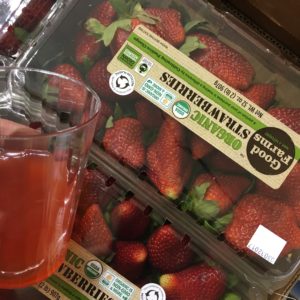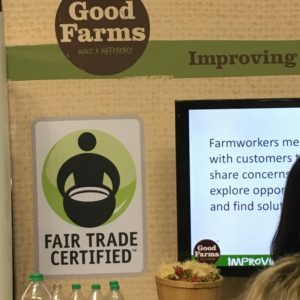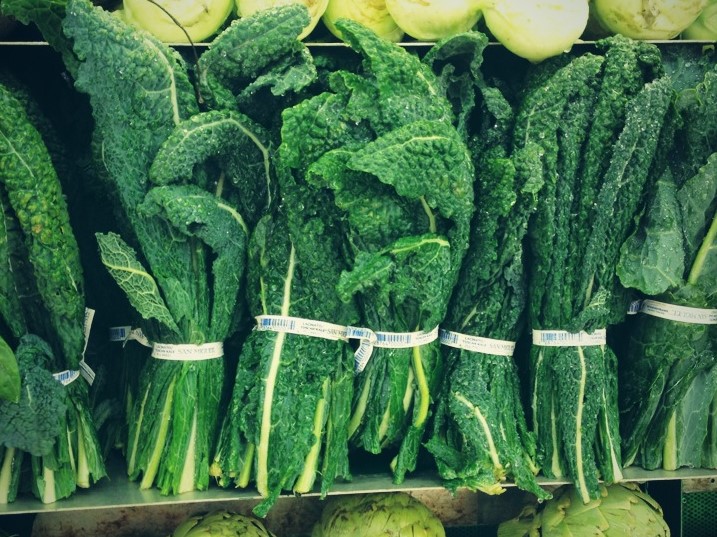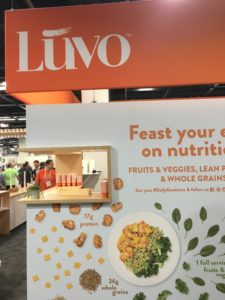Disclosure: this is NOT a sponsored post (no compensation, product, or freebies were offered to entice me to write it), and is neither written nor endorsed by Good Farms. Per usual, the choice of subject matter and all of the opinions here are mine. This is the first of my posts inspired by #ExpoWest
This weekend was the industry meeting, trade show, and adult trick-or-treating extravaganza known as Natural Products Expo West: a gathering of more than 100,000 people with exhibits/booths for more than 3,000 companies. For 2017, I can’t think of a better find to spotlight than Good Farms. Remember my last post about food waste? I had a lot of conversations around food waste at Expo West (which itself produces quite a bit of waste, but that’s a subject for another time). One of the most promising trends in the natural foods space is using “waste” products instead of putting them in the trash. (All that fancy coconut water people are sipping? Did you ever think about where the rest of the coconut goes?)
Enticed by strawberry juice! Friday morning I made my way to the Arena section, an entire room I missed last year, when I came upon a booth decked out in strawberries with a video slide show. If you know me, you know I’m a total strawberry junkie: I have fond memories of spending a day each summer picking strawberries with my family at Blessed’s Strawberry Farm (“one for the basket, two for me”) and filling the “way back” of the station wagon with berries; when I lived in Oregon I anxiously awaited the annual Burgerville strawberry milkshake season; most recently I wait for the spring farmer’s markets to open so I can buy directly from the farmers. When I saw strawberries, I was drawn like a bee to a blossom and let me tell you–SO worthwhile!
Right,back to the juicy goodness. Good Farms’ cold-pressed, organic strawberry juice is simply wonderful. You can smell the strawberries as the cup nears your face (since the juice is not heated, the volatile organic compounds that create the strawberry’s aroma remain mostly intact). The juice tastes just like biting into a strawberry, minus the pulp and seeds. It is very flavorful–I could see using a few splashes in my fizzy water to make a refreshing mocktail. While I didn’t check the nutrition label, I know it is fruit juice…so I’m glad it comes in 14.5 ounce bottles instead of gallons (as otherwise I’d drain the whole jug much too quickly). If you’d like to get your hands on some, try Costco, Whole Foods, Chick-fil-A, Panera, and meijer. (Note those are the Good Farms partners, not necessarily all of them will have the strawberry juice, which is currently in limited production.)

Ugly reject strawberries make great juice. That’s because there are nothing wrong with the strawberries, which come from organic strawberry farms in Mexico; they simply don’t meet the beauty standards supermarkets set for strawberries. Using these berries instead of treating them like garbage not only results in delicious juice, it also makes sure farmers get paid for their crop, farmworkers can earn a better wage (more sold produce = higher profit = more money to pay wages), and it is a responsible use of the resources that went into farming the berries in the first place (including water, soil/dirt/land, and labor). Finally, it prevents the berries from ending up in a landfill, where they would either remain intact for centuries (as in a standard landfill, where the ever-increasing materials on top deprive those on the lower levels of the air necessary to rot), or decay and produce gases and contribute to climate change (if put onto a dump-style trash pile).
But wait, there’s more! If you’re following along to this point, you may have the same question I had: “Wait, after the strawberries are juiced, what happens to the smushed-up berry parts?” That’s wasted, right? WRONG! At Expo West I had the opportunity to talk to some of the Good Farms project team. The great guys in the booth were kind and patient with all of my questions. They explained that the juice project is currently a small operation–two trucks of berries per week–because it is important to get the process, production, and finished product done well before scaling up. (That way you can scale as time and resources permit, staying true to your original vision.) They are working to connect the farms with secondary markets for the smashed berry parts, such as companies that make all-fruit frozen pops. I imagine those berries would also be useful to companies that make yogurt, smoothies, and dried fruit products.
It’s not just about the strawberries–it’s about the farmers. Every piece of produce has people behind it. In the US, we have typically treated farm workers poorly. While I haven’t studied the socio-economics of why, I imagine the shift from slave labor to poorly paid sharecropper labor (read: racism and the resulting racial and economic inequality) play a role. The framers of the US Constitution were landed, white gentry who definitely thought themselves more valuable and worthy than everyone else (e.g. the First Nations who already lived in the Americas, slaves, indentured servants, women). The Good Farms strawberry farms are in Mexico; in the US the workers who pick strawberries are almost always migrant farm workers, typically without access to education, social services, or medical care. Farm workers tend to move to follow the crops (where the work is), which means children who should be in school may be in multiple schools each school year, every year, making them more likely to fall behind academically and less likely to graduate from high school or pursue higher education. Female farm workers are subject to a high level of sexual harassment and assault, often at the hands of the bosses who are supposed to be protecting them. One report I heard on NPR (morning of 3/13/17) estimated that 45% of the farm workers in California are undocumented, which means they don’t enjoy many of the legal protections that US workers are entitled to, such as minimum wage, rest periods, and meal breaks. It also means that women who are sexually harassed or abused are less likely to seek help for fear of being deported and separated from their children. California only recently (since I moved here in 2008) passed laws mandating access to shade and clean drinking water for farm workers. We’ve got a LONG way to go here.
Good Farms is moving the needle. Good Farms is a stakeholder in the Equitable Food Initiative (EFI). You can read more about EFI on their website, but the basic gist is this: treating workers better (through fair wages and labor practices, access to education, sensible pesticide policies, proper protective equipment and safety protocols) is the right thing to do. EFI goes beyond third-party audits (like when OSHA shows up to spot-check your operation) by creating an on-farm team that is responsible for implementation and maintenance of their program. EFI partners include the United Farm Workers Union and Oxfam America. This is true of all of their farms, not just the strawberry farms. The Good Farms strawberry farms are also fair trade, certified by Fair Trade USA. You probably don’t even consider whether terrorists or slave-labor was involved in producing the food on your plate, but Good Farms does: C-TPAT (Customs-Trade Partnership Against Terrorism) helps them keep terrorists and terrorism out of the food chain by working with companies to protect and secure cargo, and with CIERTO to create transparent, safe labor contracts and help eliminate slavery. (Maybe you’ve heard about child slave labor used to obtain cacao? Slavery isn’t just a chocolate problem.)

A few other notables. Good Farms works with Feeding America and other food banks to donate produce instead of wasting it (not just strawberries, of course), to the tune of 350,000 pounds in 2016. They have outside auditing for their organic standards (CCOF) and food safety (PrimusGFS). Good Farms helps their farmers in Mexico by partnering with Mexican social responsibility programs that educate workers on their rights and how to exercise them; they help undocumented Mexicans living in Mexico obtain birth certificates (because without them, you can’t fully participate or exercise your rights–yet many economically disadvantaged Mexicans have never had a birth certificate). Good Farms partnered with Costco to provide disaster relief. With IEEA they provide education to farmworkers, by giving children backpacks with school supplies they reduce barriers to childhood education, and by maintaining websites and consumer outreach they teach us how to eat more vegetables and enjoy them.
Food security is a privilege. If you’re reading this, there’s a good chance you are a lot like me: safe place to sleep tonight, not worried about where my next meal is coming from, enough income from my relatively-cushy job (where I do not perform manual labor in a hunched-over position like the farm workers in this video on the UFW facebook page) to make discretionary purchases, leisure time to pursue personal interests. I’ve never gone to bed hungry because I have always had access to plenty of food. My parents had access to education and paved the way for my life, where I had even better opportunities. Most of the world is not so lucky. I’m willing to pay a little more for a quality product that improves the lives of those whose work produces the food on my table, because I can.
How about you?




